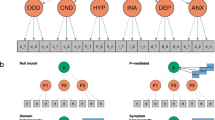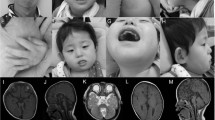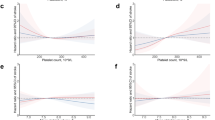Abstract
The 894G>T single nucleotide polymorphism (SNP) in the endothelial NOS (NOS3) gene, has recently been associated with embryonic spina bifida risk. In this study, a possible association between the NOS3 894G>T SNP and spina bifida risk in both mothers and children in a Dutch population was examined using both a case-control design and a transmission disequilibrium test (TDT). Possible interactions between the NOS3 894G>T SNP and the MTHFR 677C>T SNP, elevated plasma homocysteine, and decreased plasma folate concentrations were also studied. The NOS3 894TT genotype did not increase spina bifida risk in mothers or children (OR 1.50, 95%CI 0.71–3.19 and OR 1.78, 95%CI 0.75–4.25, respectively). The TDT demonstrated no preferential transmission of the NOS3 894T allele (Χ 2 = 0.06, P = 0.81). In combination with the MTHFR 677TT genotype or elevated plasma homocysteine concentrations, the NOS3 894GT/TT genotype increased maternal spina bifida risk (OR 4.52, 95%CI 1.55–13.22 and OR 3.38, 95%CI 1.46–7.84, respectively). In our study population, the NOS3 894GT/TT genotype might be a risk factor for having a spina bifida affected child in mothers who already have an impaired homocysteine metabolism.
Similar content being viewed by others
Log in or create a free account to read this content
Gain free access to this article, as well as selected content from this journal and more on nature.com
or
References
Brown KS, Kluijtmans LA, Young IS, Woodside J, Yarnell JW, McMaster D, Murray L, Evans AE, Boreham CA, McNulty H, Strain JJ, Mitchell LE, Whitehead AS (2003) Genetic evidence that nitric oxide modulates homocysteine: the NOS3 894TT genotype is a risk factor for hyperhomocysteinemia. Arterioscler Thromb Vasc Biol 23:1014–1020
Brown KS, Cook M, Hoess K, Whitehead AS, Mitchell LE (2004) Evidence that the risk of spina bifida is influenced by genetic variation at the NOS3 locus. Birth Defects Res Part A Clin Mol Teratol 70:101–106
Danishpajooh IO, Gudi T, Chen Y, Kharitonov VG, Sharma VS, Boss GR (2001) Nitric oxide inhibits methionine synthase activity in vivo and disrupts carbon flow through the folate pathway. J Biol Chem 276:27296–27303
den Heijer M, Blom HJ, Gerrits WB, Rosendaal FR, Haak HL, Wijermans PW, Bos GM (1995) Is hyperhomocysteinaemia a risk factor for recurrent venous thrombosis? Lancet 345:882–885
Fairchild TA, Fulton D, Fontana JT, Gratton JP, McCabe TJ, Sessa WC (2001) Acidic hydrolysis as a mechanism for the cleavage of the Glu(298)->Asp variant of human endothelial nitric-oxide synthase. J Biol Chem 276:26674–26679
Heil SG, den Heijer M, Van Der Rijt-Pisa BJ, Kluijtmans LA, Blom HJ (2004) The 894G>T variant of endothelial nitric oxide synthase (eNOS) increases the risk of recurrent venous thrombosis through interaction with elevated homocysteine levels. J Thromb Haemost 2:750–753
Hingorani AD, Liang CF, Fatibene J, Lyon A, Monteith S, Parsons A, Haydock S, Hopper RV, Stephens NG, O’Shaughnessy KM, Brown MJ (1999) A common variant of the endothelial nitric oxide synthase (Glu298->Asp) is a major risk factor for coronary artery disease in the UK. Circulation 100:1515–1520
Lee QP, Juchau MR (1994) Dysmorphogenic effects of nitric oxide (NO) and NO-synthase inhibition: studies with intra-amniotic injections of sodium nitroprusside and NG-monomethyl-l-arginine. Teratology 49:452–464
Murad F (2006) Shattuck lecture. Nitric oxide and cyclic GMP in cell signaling and drug development. N Engl J Med 355:2003–2011
Nachmany A, Gold V, Tsur A, Arad D, Weil M (2006) Neural tube closure depends on nitric oxide synthase activity. J Neurochem 96:247–253
Plachta N, Traister A, Weil M (2003) Nitric oxide is involved in establishing the balance between cell cycle progression and cell death in the developing neural tube. Exp Cell Res 288:354–362
Purcell S, Cherny SS, Sham PC (2003) Genetic power calculator: design of linkage and association genetic mapping studies of complex traits. Bioinformatics 19:149–150
Sofowora G, Dishy V, Xie HG, Imamura H, Nishimi Y, Morales CR, Morrow JD, Kim RB, Stein CM, Wood AJ (2001) In-vivo effects of Glu298Asp endothelial nitric oxide synthase polymorphism. Pharmacogenetics 11:809–814
Spielman RS, McGinnis RE, Ewens WJ (1993) Transmission test for linkage disequilibrium: the insulin gene region and insulin-dependent diabetes mellitus (IDDM). Am J Hum Genet 52:506–516
Stamler JS, Osborne JA, Jaraki O, Rabbani LE, Mullins M, Singel D, Loscalzo J (1993) Adverse vascular effects of homocysteine are modulated by endothelium-derived relaxing factor and related oxides of nitrogen. J Clin Invest 91:308–318
te Poele-Pothoff MT, van den Berg M, Franken DG, Boers GH, Jakobs C, de Kroon IF, Eskes TK, Trijbels JM, Blom HJ (1995) Three different methods for the determination of total homocysteine in plasma. Ann Clin Biochem 32:218–220
Tesauro M, Thompson WC, Rogliani P, Qi L, Chaudhary PP, Moss J (2000) Intracellular processing of endothelial nitric oxide synthase isoforms associated with differences in severity of cardiopulmonary diseases: cleavage of proteins with aspartate vs. glutamate at position 298. Proc Natl Acad Sci USA 97:2832–2835
Topal G, Brunet A, Millanvoye E, Boucher JL, Rendu F, Devynck MA, vid-Dufilho M (2004) Homocysteine induces oxidative stress by uncoupling of NO synthase activity through reduction of tetrahydrobiopterin. Free Radic Biol Med 36:1532–1541
Traister A, Abashidze S, Gold V, Plachta N, Karchovsky E, Patel K, Weil M (2002) Evidence that nitric oxide regulates cell-cycle progression in the developing chick neuroepithelium. Dev Dyn 225:271–276
van Beynum IM, Smeitink JA, den Heijer M, te Poele Pothoff MT, Blom HJ (1999) Hyperhomocysteinemia: a risk factor for ischemic stroke in children. Circulation 99:2070–2072
van der Linden IJ, Den Heijer M, Afman LA, Gellekink H, Vermeulen SH, Kluijtmans LA, Blom HJ (2006) The methionine synthase reductase 66A>G polymorphism is a maternal risk factor for spina bifida. J Mol Med 84:1047–1054
Weil M, Abeles R, Nachmany A, Gold V, Michael E (2004) Folic acid rescues nitric oxide-induced neural tube closure defects. Cell Death Differ 11:361–363
Acknowledgements
This study was supported by the Prinses Beatrix Fonds, The Netherlands (MAR04-0121), the Dutch Kidney Foundation (C042083) and the NIH (1 R01 NS050249-01A1). Martin den Heijer is supported by The Netherlands Organization for Scientific Research (VENI grant NWO).
Author information
Authors and Affiliations
Corresponding author
Rights and permissions
About this article
Cite this article
van der Linden, I.J.M., Heil, S.G., den Heijer, M. et al. The 894G>T variant in the endothelial nitric oxide synthase gene and spina bifida risk. J Hum Genet 52, 516–520 (2007). https://doi.org/10.1007/s10038-007-0147-0
Received:
Accepted:
Published:
Issue date:
DOI: https://doi.org/10.1007/s10038-007-0147-0



